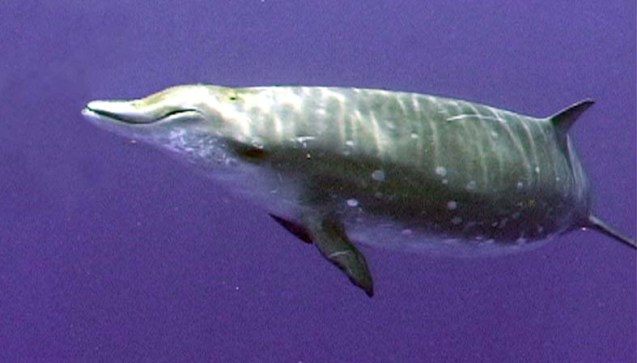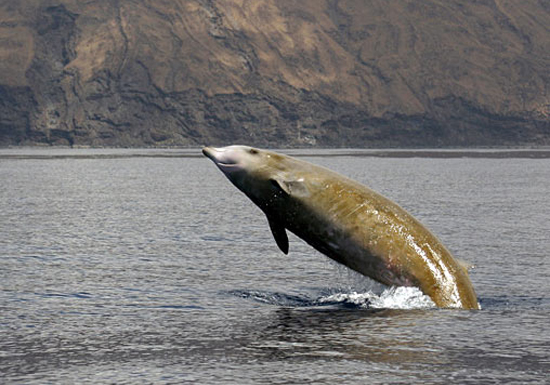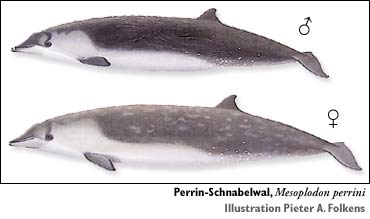How Many New Beaked Whales Are Out There?
Posted by: Loren Coleman on August 18th, 2011

A month ago, Australian officials found a beached whale. They thought it was a minke, but recently announced it was a Cuvier’s beaked whale (Ziphius cavirostris) – one of only four discovered in the past 150 years by the Queensland Museum. Cuvier’s beaked whales are one of 21 known beaked whale species. It is clear that this is only the tip of the iceberg.
Georges Cuvier first described this species in 1823 from part of a skull found in France in 1804. He thought it represented an extinct species — it wasn’t until the 1870s that it was realized the type specimen represented a living species.
Beaked whales, by far, are the most frequent new marine mammal to be discovered. How many are out there?

Scientific Name:
Common Name/s:
| English | – | Perrin’s Beaked Whale |
| French | – | Mésoplodon De Perrin |
| Spanish | – | Zifio De Perrin |

Perrin’s beaked whale (Mesoplodon perrini)
For more on the new cetaceans discovered since 2000, see here.
About Loren Coleman
Loren Coleman is one of the world’s leading cryptozoologists, some say “the” leading living cryptozoologist. Certainly, he is acknowledged as the current living American researcher and writer who has most popularized cryptozoology in the late 20th and early 21st centuries.
Starting his fieldwork and investigations in 1960, after traveling and trekking extensively in pursuit of cryptozoological mysteries, Coleman began writing to share his experiences in 1969. An honorary member of Ivan T. Sanderson’s Society for the Investigation of the Unexplained in the 1970s, Coleman has been bestowed with similar honorary memberships of the North Idaho College Cryptozoology Club in 1983, and in subsequent years, that of the British Columbia Scientific Cryptozoology Club, CryptoSafari International, and other international organizations. He was also a Life Member and Benefactor of the International Society of Cryptozoology (now-defunct).
Loren Coleman’s daily blog, as a member of the Cryptomundo Team, served as an ongoing avenue of communication for the ever-growing body of cryptozoo news from 2005 through 2013. He returned as an infrequent contributor beginning Halloween week of 2015.
Coleman is the founder in 2003, and current director of the International Cryptozoology Museum in Portland, Maine.










See there’s new species being discovered that aren’t just a few inches long. I decided long ago, if ever there was a chance of big cryptids roaming the planet, the easiest and most logical place to find them will be the oceans. That environment alone can not only support but hide some really huge stuff.
That’s why I’m sold on sea serpents–still not set on what exactly they are and which they descended from, but I believe that the idea that there is no such thing is way more ridiculous than the fact that there’s still big critters roaming our oceans…and maybe a few lochs and lakes too…
Beautiful animals and an interesting read.
Well, scientific work in the post-genomic era has changed our view on the relationships between many species that seem all to related from a morphological standpoint.
SpringHeeledJack,
I can promise you, without reservation, that we will find many ‘sea monsters’ and ‘sea serpants’ over the next 5-10 decades. We are going deeper and deeper into the sea and finding more and more amazing creatures.
Although if Megladon DOES still exist I don’t know that I’ll ever go deep sea fishing again. Logic will not help me on this one. I’m slightly phobic of bull sharks and great whites so I can’t imagine what I’d do if the possibility of something THAT huge being underneath the ship rears its head.
But new squids, crabs, fish, whales…constantly finding new species everytime we go under. Its fabulous!!
Not only new species, but an entire new genus of beaked whales was discovered based on the examination of remains of whales dating from 1882 to 1955. The new genus is known as Indopacetus pacificus, also known as the Indo-Pacific beaked whale or Longman’s beaked whale in honor of the man who first recognized the whale as something unique. A living specimen of this species has never been obtained, and it is known from only photographs, sightings, video footage, five skulls, and one complete skeleton.
Beaked whales are notoriously difficult to find, as they are extremely shy and elusive. They are known to dive under at the sound of any human activity, such as boats and not resurface until the disturbance is long gone. You could pass right by them and not even know they were there. In addition, they tend to live in areas where there are not many people around to begin with.
As I noted in an article I wrote here fairly recently on Cryptomundo covering this topic, Beaked whales are famously shy and difficult to study. Even researchers actively studying beaked whales rarely see them, and due to this there are many instances of very recently discovered species known from only a handful of specimens and sightings. In many cases, such as with the aforementioned I. pacificus , a living specimen has never been obtained.
As mentioned here, Perrin’s beaked whale (Mesoplodon perrini) for instance, has never been recorded alive. It is known from 5 specimens, the first found in 1975, all found off the coast of California between San Diego and Monterey. It was formally described in 2002. Shepherd’s beaked whale, also known as the Tasman whale, is known from only four specimens. The Pygmy beaked whale (Mesplodon peruvianus) was originally discovered off Peru in 1991 and is known from only twelve specimens. The list goes on.
On another note, I also noted in my article that new species of beaked whales, although the most commonly discovered, are not the only type of new whale being uncovered in the deep.
A Japanese team of researchers identified a new species of baleen whale based on evidence from specimens starting in the 1970s and formally described the new species in 2003. Known now as Balaenoptera omurai, it was the first new species of baleen whale (filter feeding whales) identified in nearly a hundred years.
It illustrates that a large creature can be wary of humans and remain undetected in the deep. Perhaps not only whales, but other types of large sea animals are doing the same thing.
This all reminds me of just how many mysterious animals other than obvious whales have been seen and described by not only seamen or fisherman, but also trained biologists who are still not quite sure what it is they saw. Animals have been described and illustrated by naturalists and biologists in the sea over the years that have never been formally recognized, and remain enigmas.
The seas are a vast and mysterious place, with boundless examples of new discoveries, often of large or surprising animals, being made. The oceans are also constantly showing us unusual evolutionary paths and various oddities. It is in the seas where we have uncovered completely new types of life, for instance extremophiles such as deep sea vent communities almost completely independent of the need for sunlight at all, and sulphur based whale fall communities, creatures which defy some traditional ideas of biology. The sea holds all sorts of opportunities to make weird discoveries.
I’m not sure if it will necessarily be something as “sexy” as Megladon, but one thing is for sure; concerning the next truly groundbreaking big animal discovery, my money would be on the oceans.
Wow, my first characteristic long comment in awhile. 🙂 With interesting topics like this, I just can’t help myself.
I find these finds very exciting, and look forward to more, which I’m sure we will. Technology has changed how we view and discover different species.
Flame821
Well said! Exciting stuff isn’t it? Though I must agree, I may never want to go deep sea fishing again if they find a megladon, or even a leviathan whale! 🙂 We are scheduled to go to the Cape and deep sea fishing next Monday and Mr Meg will likely be a topic of conversations, along with the great whites and gray seals!